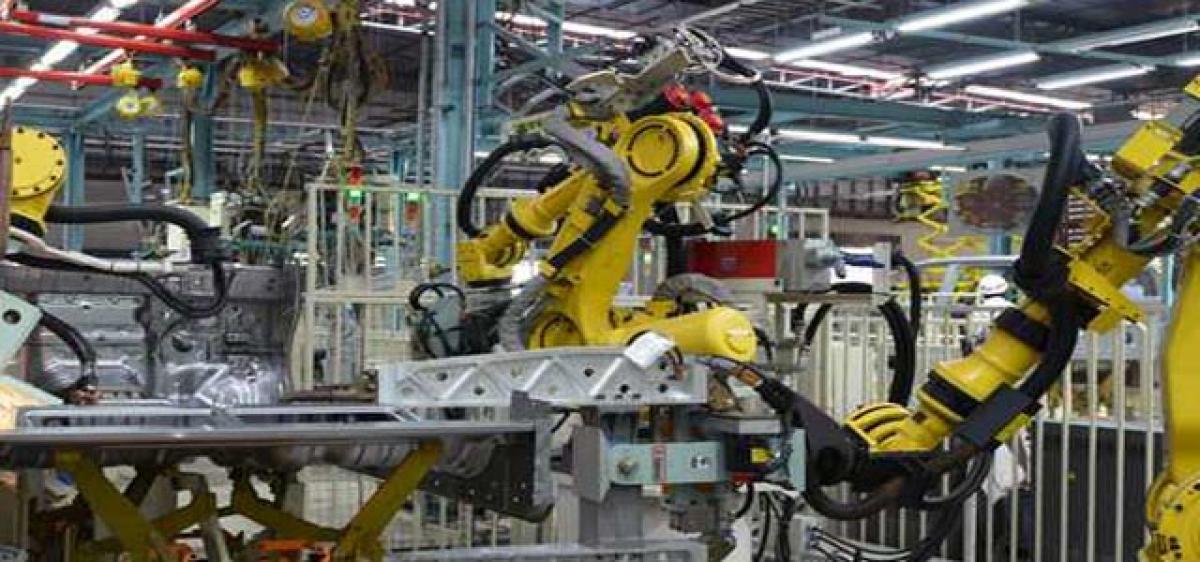Live
- Allu Arjun Arrested: KTR Reacts on X, Calls Arrest Unfair
- Bold steps by Modi govt in reviving Indian heritage, culture: Union Minister
- What are the charges against Allu Arjun: Understanding the Charges Against Him
- Allu Arjun Objects to Arrest Procedure, Requests Breakfast and Change of Clothes
- ‘Fear’ movie review: A gripping suspense thriller
- Phenom Successfully Hosts IAMPHENOM India, Transforming the Future of Work with AI, Automation, and Talent Experience
- Constitution provides shied, guarantee to Indians: Priyanka in LS
- Allu Arjun’s Quash Petition Hearing at 2:30 PM; Chiranjeevi Visits Police Station
- Bommai hails 'One Nation, One Election' move as PM Modi’s bold decision
- Telangana IT Minister D. Sridhar Babu Highlights Future City Vision and Data Center Growth at IAMPHENOM Event
Just In

The most recent Purchasing Manager\'s Index (PMI) reflects a contraction in the manufacturing activity in India in December.
The most recent Purchasing Manager's Index (PMI) reflects a contraction in the manufacturing activity in India in December. Most domestic and international analysts and experts are looking at it from the viewpoint of the move of the government which essentially removed 86 per cent of the currency as legal tender.
The unprecedented move does seem to have had an adverse impact on the manufacturing and investment activity. Its benefits, at best, are uncertain at present though the government has been lauding the move from the viewpoint of recovering tax from income tax raids as well as the ability to levy tax on declared income beyond a threshold.
Another positive the government has been vocal about is the change expected in behaviour of people to a less-cash economy. The All India Manufacturers' Organisation has, meanwhile, issued a study which shows a 50 per cent dip in revenues and 35 per cent job losses for SMEs. The government must carefully look into these figures.
Over the years, if one looks at the performance of the manufacturing sector, it has not been among the best performers. There are a number of reasons for this. A recent report by the Institute for Competitiveness, an international think-tank, looks at some of these aspects as well as compiles an index of manufacturing competitiveness for Indian states.
The report notes that the share of manufacturing has been stagnant at roughly 15 per cent of GDP for the past 30 years in contrast to services, which have grown, and agriculture, which has shrunk during this period. The report brings out four essential points on India's manufacturing competitiveness.
First, it traces the development of the sector and notes that the possible reason for its non-performance is due to crucial reforms not happening. It notes that India's initial market opening process did include reforms in the capital markets and FDI into distinct sectors. However, market reforms initially remained untouched. These included labour legislation and laws pertaining to land markets. Even today, they remain restrictive for investment and competitiveness to grow.
The reforms largely helped in the development of the service industry but could not enable the rise of the manufacturing industry, which, in addition, required critical linkages like electricity, water and reduction in burdensome regulations. However, these were not initially available, which resulted in services taking off while manufacturing lagged. Thus, only some states are good in manufacturing.
The second point is the important locations for manufacturing. The best states in this regard are Maharashtra, Tamil Nadu and Gujarat, that can be thought to be at the forefront of manufacturing competitiveness. They are also good in industrial clusters and SMEs. The northeastern states and states like Bihar and Jharkhand perform relatively poorly on the composite index. The reasons for these are many and complex, but their inability to provide a stable environment for investment in manufacturing to take place is the primary factor.
Third, another major factor for India to consider over the medium to long term is automation. Most Indian businessmen and policymakers are not according it the attention automation and the rise of the robots should be getting. The need for paying attention to this is simple. The Make in India national manufacturing policy aims to create 100 million additional jobs by 2022. Even if the manufacturing sector has a multiplier of 5, generating 20 million jobs is not easy. And that too in an environment where automation is fast replacing manual jobs.
China's manufacturing workforce is under tremendous stress as technological innovation disrupts manual jobs. India needs to adapt to this changing reality and adjust its manufacturing sector considering the changes under way at the technological level globally.
Finally, the focus of governments in India should be on a manufacturing competitiveness ecosystem which thinks about the meaningful interactions between humans, capital and factories for productive employment. Over the years, India's policymakers need to be vigilant about the technological disruption that could severely impact manufacturing and job growth in India and align their policies accordingly.
By Amit Kapoor

© 2024 Hyderabad Media House Limited/The Hans India. All rights reserved. Powered by hocalwire.com







